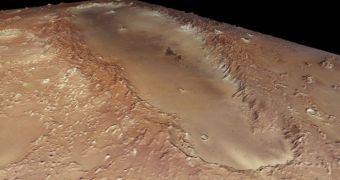For years, astronomers have known about the existence of the peculiar, elliptical Orcus Patera crater on Mars, but it was only recently that experts at the European Space Agency (ESA) took a closer look at the structure.
The landscape feature is located between two Martian volcanoes, called Elysium Mons and Olympus Mons, and its home is one of the main reasons it remained so mysterious.
The elliptical depression can be found near the Red Planet's equator, in the eastern hemisphere. It extends for about 380 kilometers, and has a width of about 140 kilometers.
The feature is oriented in a NNE-SSW direction, and its rim extends more than 1,800 meters above its surroundings. This means that whatever caused the indentation really hit Mars with all it had.
From photos collected thus far, researchers determined that the bottom of the crater reaches a depth of about 400 to 600 meter below the surroundings. This means that the total elevation difference in the crater is between 2,200 and 2,400 meters.
Even though the word patera is oftentimes used to refer to a volcanic crater that is irregular in shape and of unusual dimensions, the name of this particular feature does not necessarily reflect its origin.
That is to say, geologists and planetary scientists are still having a hard time determining whether this feature is a volcano crater. The structure could be an eroded or compressed round impact crater.
Alternatively, it could have developed as a collection of smaller craters, which were joined together by erosion, ESA experts say.
They add that the most viable explanation for how Orcus Patera appeared is that the feature was produced by a small space object, which impacted the Red Planet at a very shallow angle.
If that is indeed the case, than the impactor had to have struck Mars at a 5-degree inclination from the horizontal, in order to produce such a long indentation in the ground.
But determining whether this is actually what happened is a very complex process, considering that particular structures at the crater, called graben, indicate the existence of tectonic processes at the location.
This means that the overall shape of the crater may have been produced by compression forces as well, not only by an initial impact.
Determining whether that was the case, or the extent to which such a process influenced the structure's final shape, is still a matter to be resolved.

 14 DAY TRIAL //
14 DAY TRIAL //